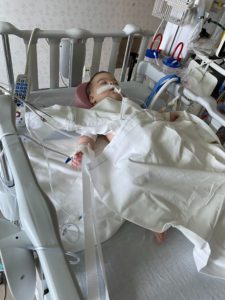Early Scans Saved Our Son

 I was shaken awake — my wife’s hand on my back. It was still pitch black in our Cincinnati hotel room. Blurry-eyed, I glanced at the nightstand. 4:30 a.m., the glowing screen read.
I was shaken awake — my wife’s hand on my back. It was still pitch black in our Cincinnati hotel room. Blurry-eyed, I glanced at the nightstand. 4:30 a.m., the glowing screen read.
“Everything ok?” I asked, still half asleep.
“He has a high-risk brain AVM,” she said. “They posted the results in MyChart.”
The words hung in the room. My wife and I had driven from Chicago to the HHT Center of Excellence at Cincinnati Children’s Hospital to have our then 5-month-old son, JB, tested and scanned. I’m an HHT patient myself. And like so many others, this disease has had a profound impact on my extended family.
Sitting in that dark hotel room, the hours felt like days as we waited to leave for our appointment to fully review the results. Tears welled in both our eyes as we looked down at our son, angelically asleep, blissfully unaware.
When the appointment finally arrived, with the clinical team taking us through next steps, I remember feeling scared. Even guilty. I passed this along to my son. There was anger, too. All of it. All at once.
But I also remember feeling something else; Fortunate. Yes, fortunate. In many ways, we are the fortunate ones. Our family has a known diagnosis. We knew to get our son scanned early.
It’s a widely stated statistic: As many as 90% of HHT patients remain undiagnosed today. Far too often, it takes a tragic event for a diagnosis to finally come to light. A tragic event that, in many cases, could have been prevented. Even with a diagnosis, far too many continue not to receive proper scans. “It’s just nosebleeds,” is a refrain we’ve all heard too often. Yes, HHT can be a brutal and unfair disease. But knowledge can also be power.
 Our road, however, has indeed been brutal at times. It took us to Cincinnati and back multiple times and ultimately led us to the Barrow Neurological Institute in Arizona, where the AVM was removed via craniotomy when he was just 9-months old. Many sleepless nights in the PICU followed.
Our road, however, has indeed been brutal at times. It took us to Cincinnati and back multiple times and ultimately led us to the Barrow Neurological Institute in Arizona, where the AVM was removed via craniotomy when he was just 9-months old. Many sleepless nights in the PICU followed.
With June being HHT awareness month, it felt like a fitting time to share our story. Because it has a very different ending without awareness. My son never presented with symptoms. Externally, he appeared as healthy as could be – hitting all his developmental milestones.
Simply put, early scans saved our son’s life.
Surgery was successful, the AVM was fully removed, and we are astonished by his resiliency as we had our smiley, giggly little boy back in no time… with the only lingering evidence of the hectic few months being the scar atop his head. Relief is an understatement. But as we learned more about our path forward that first day in Cincinnati, I thought about those impossible-to-forget HHT stories. I thought about families who are unfamiliar with the disease, uncertain of what lies ahead, and unsure where to turn for help. Those with even more dire manifestations of the disease. Those with harder roads ahead.
We also thought about how thankful we are for Cure HHT and all it does to advocate for patients and push for progress. Without the work of this foundation, often occurring behind the scenes, we wouldn’t have access to the specialized care my son received. This foundation truly is a resource to help this community navigate the complex care and treatment HHT often requires. It helped us get the best possible care for our son.
It was in those moments that the seed of an idea was planted; It would be incredibly fulfilling to use whatever skills I have to help the organization that has helped my son, my family, myself, and so many others.
Following several conversations with my wife, with Marianne, Nicole, and this incredible team, it led us here to Cure HHT — to help this hard-charging group continue to fight on the behalf of patients around the globe.
A picture of my wife holding my son following his first surgery sits on my desk; A personal reminder of why the work this foundation does is so important. And why we must keep pushing.
As Director of Marketing and Communications at the foundation, there’s only so much I can do individually to advance that mission. But I’ve quickly learned how mighty this community is. Together, we can further awareness, influence better treatment, and make an impact.
Together, we can do our part to ensure more HHT stories end like my son’s. As a patient and caregiver now on the “inside,” it’s wildly encouraging to see all the transformation within reach. There’s real reason to be optimistic for seismic advancements within my son’s lifetime — and within mine, for that matter. But it’s also clear how urgently we need to keep going.
Here’s to that journey… Let’s cure this damn thing.
